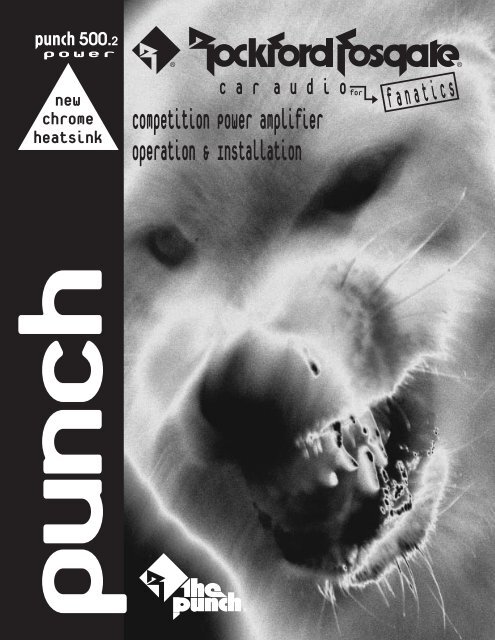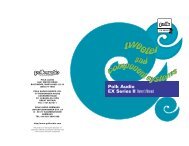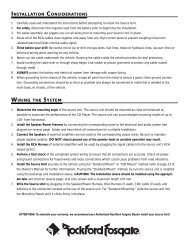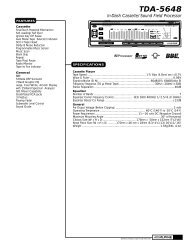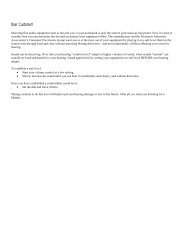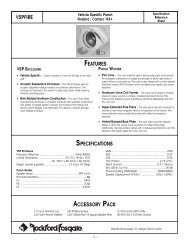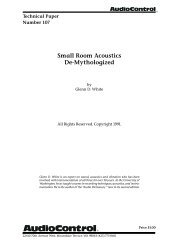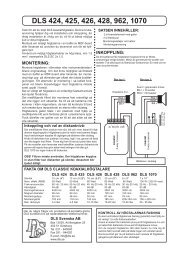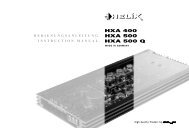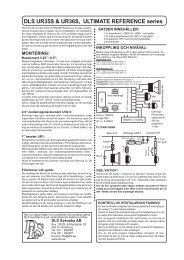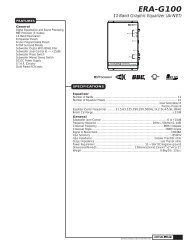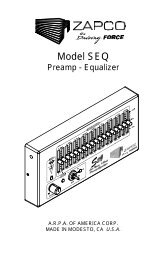⢠Punch 500.2
⢠Punch 500.2
⢠Punch 500.2
You also want an ePaper? Increase the reach of your titles
YUMPU automatically turns print PDFs into web optimized ePapers that Google loves.
<strong>500.2</strong>powernewchromeheatsink® ®c a r a u d i ocompetition Power amplifierOperation & Installationforfanaticspunch®
Dear Customer,Congratulations on your purchase of the world's finest brand of car audio amplifiers. At Rockford Fosgate weare fanatics about musical reproduction at its best, and we are pleased you chose our product. Through yearsof engineering expertise, hand craftsmanship and critical testing procedures, we have created a wide range ofproducts that reproduce music with all the clarity and richness you deserve.For maximum performance we recommend you have your new Rockford Fosgate product installed by anAuthorized Rockford Fosgate Dealer, as we provide specialized training through Rockford Technical TrainingInstitute (RTTI). Please read your warranty and retain your receipt and original carton for possible future use.Great product and competent installations are only a piece of the puzzle when it comes to your system. Makesure that your installer is using 100% authentic installation accessories from Connecting <strong>Punch</strong> in yourinstallation. Connecting <strong>Punch</strong> has everything from RCA cables and speaker wire to Power line and batteryconnectors. Insist on it! After all, your new system deserves nothing but the best.To add the finishing touch to your new fanatic image order your Rockford Fosgate wearables, which includeeverything from T-shirts and jackets to hats and sunglasses.To get a free brochure on Rockford Fosgate products and Rockford wearables, please call 602-967-3565 or FAX602-967-8132. For International orders, FAX +001-1-602-967-8132 or call +001-1-602-967-3565.PRACTICE SAFE SOUNDCONTINUOUS EXPOSURE TO SOUND PRESSURE LEVELS OVER 100dB MAY CAUSE PERMANENTHEARING LOSS. HIGH POWERED AUTOSOUND SYSTEMS MAY PRODUCE SOUND PRESSURE LEVELSWELL OVER 130dB. USE COMMON SENSE AND PRACTICE SAFE SOUND.If, after reading your manual, you still have questions regarding this product, we recommend that you see your Rockford Fosgatedealer. If you need further assistance, you can call us direct at 1-800-669-9899. Be sure to have your serial number, model numberand date of purchase available when you call.The serial number can be found on the outside of the box. Please record it in the space provided below as your permanent record.This will serve as verification of your factory warranty and may become useful in recovering your amplifier if it is ever stolen.Serial Number: _____________________________________________Model Number: ____________________________________________
® ®T ABLE OF CONTENTSIntroduction................................................................................................................................................................. 1Accessory Pack ........................................................................................................................................................... 1Technical Design Features............................................................................................................................................. 2Design Features ........................................................................................................................................................... 5Installation Considerations ............................................................................................................................................ 7Mounting Locations...................................................................................................................................................... 8Battery and Charging ................................................................................................................................................... 8Wiring the System ........................................................................................................................................................ 9Using Passive Crossovers ............................................................................................................................................ 10Table of Crossover Components ................................................................................................................................... 11Using the XCard ......................................................................................................................................................... 12Customizing the XCard ............................................................................................................................................... 12XCard Resistor Chart................................................................................................................................................... 13XCard Configurations.................................................................................................................................................. 14Installation ................................................................................................................................................................ 16Using the Balanced Line Inputs .................................................................................................................................... 19Rockford Fosgate Accessories ...................................................................................................................................... 21Troubleshooting ......................................................................................................................................................... 23Autosound 2000’s Quick Check for Troubleshooting....................................................................................................... 25Dynamic Power Measurements.................................................................................................................................... 27<strong>500.2</strong> Specifications .................................................................................................................................................. 28Warranty Information ................................................................................................................................................. 29International Information ............................................................................................................................................. 30G ETTING STARTEDWelcome to Rockford Fosgate! This manual is designed to provide information for the owner, salesperson and installer. Forthose of you who want quick information on how to install this product please turn to the Installation section of this manualor refer to the icons listed below. Other information can be located by using the Table of Contents. We, at Rockford Fosgate,have worked very hard to make sure all the information in this manual is current. But, as we are constantly finding new waysto improve our product, this information is subject to change without notice.a Od perationvancedINSTALLATIONTROUBLE-SHOOTINGSections markedADVANCEDOPERATIONinclude in-depthtechnical informationSections markedINSTALLATIONinclude “slam dunk”wiring connectionsSections markedTROUBLESHOOTINGinclude recommendationsfor curing installationproblems
INTRODUCTIONThe <strong>Punch</strong> Power series of amplifiers represent the best Rockford Fosgate has to offer! Our engineers devised technicalfeatures which would be considered overkill by other audio manufacturers, but not at Rockford Fosgate! Trans•nova,DIAMOND, and TOPAZ, exclusively designed by Rockford, are just a few of these features which are described in the TechnicalDesign Features section of this manual.ACCESSORY PACKThe accessory pack includes the mounting hardware necessary to secure the amplifier to the vehicle and to attach the endcaps to the amplifier.<strong>Punch</strong> Power <strong>500.2</strong>Installation & Operation Manual<strong>Punch</strong> Verification Certificate(4) Amplifier mounting screws (#8 x 3 ⁄4" phillips)(4) Speaker connector screws (3/32" allen)(2) Power connector screws (1/8" allen)(4) End cap mounting screws (9/64" allen)(1) Allen wrench 3/32" (speaker)(1) Allen wrench 9/64" (end cap)(1) Allen wrench 1/8" (power)– 1 –
TECHNICAL DESIGN FEATURES◆ trans•nova (TRANSconductance NOdal Voltage Amplifier)The trans•nova (TRANS conductance NOdal Voltage Amplifier) is a patented circuit (U.S. Patent 4,467,288) that allowsthe audio signal to pass through the amplifier at low voltage. Each amplifier channel utilizes its own “fully floating” powersupply and is configured to increase power gain. The increase in power gain allows the drive stage to operate at a lowervoltage. A low voltage drive stage is the same principle used in high quality preamplifiers to produce high linearity and widebandwidth.E-II-Etrans•nova circuitryThe resulting design utilizes an output stage with a simpler gain structure and a shorter total signal path than conventionalhigh voltage (bi-polar) designs. The number of stages is reduced from five or more to three. The output stage is further refinedinto a trans-impedance stage (current to voltage converter) to achieve a short loop (fast) negative feedback. The output stageis driven cooperatively by a transconductance stage (voltage to current converter).THE RESULT: Superior sound quality, greater efficiency and higher reliability.◆ DIAMOND (Dynamically Invariant AMplification Optimized Nodal Drive)DIAMOND (Dynamically Invariant AMplificiation Optimized Nodal Drive - patent pending) is an important advance in circuitdesign which reduces high frequency distortion. Amplifiers which utilize a large array of output MOSFETs cause a highcapacitive load on the driver stage. This load can make the high frequencies sound harsh. The DIAMOND circuit eliminateshigh frequency distortion by allowing the driver to operate with 20dB or more of current headroom, whereas traditional drivershave only 6dB of current headroom.THE RESULT: Lower distortion and greater inherent stability.◆ MEHSA (Maximum Efficiency Heat Sink Application)The MEHSA (Maximum Efficiency Heat-Sink Application) is a proprietary process that yields up to 5 times better heat transferthan traditional FET mounting techniques using the exact same components. A multi-layer insulated metal substrateoperating with minimal thermal resistance spreads heat both downward & outward to quickly dissipate heat from each deviceacross the heat sink. This process combined with our DSM technology and MOSFET devices allow us to squeeze more wattsper cubic inch from every output device as well as provide consistent thermal stability.THE RESULT: Optimized power output, enhanced thermal stability, and maximum component reliability.– 2 –
◆ TOPAZ (Tracking Operation Pre-Amplifier Zone)The TOPAZ (Tracking Operation Pre-Amplifier Zone) circuitry solves ground loop noise problems common to automotiveamplifier design. This innovative new development allows vastly improved isolation of the input signal grounds from thepower supply ground of the amplifier. This is accomplished by allowing the source unit to control the potential “environment”of the entire input structure or “zone” of the amplifier. This process improves the noise rejection of the amplifier by 30-40dB– an astounding 20-100 times better than amplifiers without TOPAZ.THE RESULT: Elimination of troublesome ground loop noise between source and amplifier.◆ DSM (Discrete Surface Mount Technology)The DSM (Discrete Surface Mount) manufacturing process combines the advantages of both discrete components andintegrated circuitry. Rockford Fosgate is the only American amplifier manufacturer to have invested millions into this process.DSM components differ from conventional discrete components in different ways. They are more compact, more rugged,and they efficiently dissipate generated heat. Using them wherever appropriate allows the advantages associated withdiscrete circuitry to be retained while also providing room for both highly advanced processing features and generous PCboard copper paths where needed. Their short lead-out structures allow maximum audio performance and highest signalto-noiseratios to be obtained in amplifiers of desirable package size without resorting to “amplifier-on-a-chip” shortcuts. Theseadvantages are shown below in Figure 1.Figure 1PC BoardSolderComponentSolderPC BoardThru-HoleSurface MountTHE RESULT: Less connections, improved reliability, shorter signal paths, superior signal-to-noise ratio and awesome sonicperformance.◆ XCard (Internal Crossover)The Power amplifiers utilize internal active crossovers. These crossovers have many performance advantages such as usingdiscrete components for exact frequency adjustments which are far superior to potentiometers. Additionally, the XCard canbe configured for high-pass, low-pass and full range operation. With slight modification, many crossover frequencies andslope configurations can be achieved.THE RESULT: Increased system design flexibility with a precise electronic crossover without the limitations of conventionalpotentiometer designs.◆ Stereo Pass-ThruThe Pass-Thru output provides a convenient source for daisy-chaining an additional amplifier without the need for extra RCAcables or “Y” adapters. The original signal(s) fed into the input jack(s) are looped back to the Pass-Thru outputs allowingless signal cable to be used. This results in cleaner system designs and reduces noise pick-up.THE RESULT: Convenient signal level output for adding extra amplifiers.– 3 –
◆ Bass EQThe Bass EQ helps correct for acoustical deficiencies in the listening environment. A unique potentiometer that controls basscompensates for the lack of low frequencies present in most car environments. Unlike a conventional tone control, the BassEQ corrects for the specific problem of poor low bass response.THE RESULT: Provides better low bass response.◆ Balanced Line InputsUsing the Balanced Line Inputs provides the last word in achievablerejection of noise induced in the cable between the sourceand the amplifier. The differential input circuitry (Figure 2) usedin the balanced input system rejects whatever signals arecommon to both of the shielded, twisted-pair conductors. Balancedline is universal in concert installations where the stageand mixing consoles are hundreds of feet apart. Long signalcables and electrically-noisy environments make signal integrityand noise rejection an extremely difficult challenge.Figure 2CenterConductorOuterShieldRCA InputDifferentialInputDifferential inputs only amplify the difference between two conductors.Note: the noise spikes appear on both the center conductor and the outershield and therefore are not amplified.THE RESULT: Quiet transmission of audio from source to amplifier.◆ NOMAD (NOn-Multiplying Advanced Decision)The Power amplifiers use an analog computer process to absolutely maximize safe output power under all operatingconditions. The innovative NOMAD (NOn-Multiplying Advanced Decision) system is the most sophisticated version of thistechnique ever used, bringing previously unavailable levels of accuracy, stability, temperature immunity and reliability tothis critical process. NOMAD makes advanced decisions based on device voltages to precisely control the awesome levelsof current available in the output MOSFETs to safe values – but only when absolutely needed.THE RESULT: Extremely fast protection system that always protects the amplifier and never degrades the sound.◆ MOSFET Devices (Metal Oxide Semiconductor Field Effect Transistor)Rockford Fosgate is one of the few manufacturers in any of the sound communities to utilize MOSFET devices in both the powersupply and the output stages. MOSFET (Metal Oxide Semiconductor Field Effect Transistor) devices offer several importantinherent advantages over the 30 year old technology of bi-polar design. These advantages include: thermal stability,switching speed, ultra low output impedance and wider bandwidth linearity. In addition, MOSFET and vacuum tubes sharemany important operating characteristics. However, the MOSFET device is much faster, wider in bandwidth, measurablylower in distortion and far more linear than vacuum tubes.THE RESULT: Operational characteristics of vacuum tubes without the performance limitations of tube design.– 4 –
D ESIGN FEATURES1. Cast Aluminum Chrome Heatsink – The cast aluminum heatsink of the <strong>Punch</strong> Power amplifier dissipates heatgenerated by the amplifier's circuitry. The inherent advantage of casting provides a 30% improvement of cooling overconventional extrusion heatsink designs.2. End Caps – The unique end caps conceal the wiring and input cables, giving the amplifier a clean “stealth” look.3 13 867123LL(Mono)RRSpeaker Gain Bass+ L – Phase EQ LR0 – 180° BalancedPass Thru Pass ThruUnbalancedBalancedGainInputEZ Bridged 180°- 0°Speaker– R +1011910LEDREMB+GND15 5 4 43. Speaker Terminals – The heavy duty, gold-plated terminal block connectors (+ and –) will accept wire sizes from8 AWG to 18 AWG. These gold-plated connectors are immune to corrosion that can cause signal deterioration.4. Power Terminals – The heavy duty, gold-plated power and ground connectors will accommodate 4 AWG wire formaximum input current capability.5. REM Terminal – This gold-plated spade terminal is used for the AP (auto power) or remote turn on of the amplifier.6. RCA Input Jacks – The industry standard RCA jack provides an easy connection for signal level input. They are goldplatedto resist the signal degradation caused by corrosion.7. Balanced Line Input– This input will allow the Balanced Line Transmitter (BLT) or any balanced Rockford Fosgatesource unit/signal processor to be used in conjunction with the amplifier to provide better noise rejection.8. Signal Input Switch – This switch allows selection of either the RCA or Balanced Line inputs.9. RCA Pass-Thru Jacks – The Pass-Thru provides a convenient source for daisychaining an additional amplifier,eliminating the need for “Y” adapters. The original signal(s) fed into input jack(s) are looped back to the Pass-Thruoutput(s).10. Input Sensitivity Controls – The input level controls are preset to match the output of most source units. They canbe adjusted to match output levels from a variety of source units.– 5 –
11. Bass EQ Control – The Bass EQ allows a narrow band adjustment of up to +18dB centered at 45Hz. The bass boost canbe bypassed by turning the control to its minimum or counterclockwise position.12. E-Z Bridge Switch / 0°-180° Phase Switch – This dual purpose switch enables you to E-Z bridge the amplifier or invertthe signal phase of the right channel.13. Phase Switch – This switch enables you to easily invert the phase of the left channel without having to disconnect thespeaker wires.14. Internal Crossovers – These built-in crossover cards are configurable for a multitude of operating frequencies. Theorientation of the card in its socket determines its function of high-pass, low-pass or full range operation.15. LED Power Indicator – The LED gives a visual indication of the status of the amplifier, lighting when the unit is turned on.High-PassHPXCard 1LP®AMPLIFIER250 Watts RMS continuous power perchannel into 4 Ohms with less than 0.05%Total Harmonic Distortion from 20-20kHz500 Watts RMS continuous power perchannel into 2 Ohms with less than 0.10%Total Harmonic Distortion from 20-20kHzLow-PassHPLPFull RangeFULLXCard 214®+ –Do Not ChassisGround Any Speaker.L+ R–For Bridged Mono WiringConnect 4Ω mono woofer + to L+ ofamplifier and mono woofer – to R–of amplifier. Amplifier will operatemono/stereo simultaneously.ROCKFORD CORPORATIONMADE IN THE USANOTE: Insert XCards intosockets facing each other.Please refer to Owner’s manualfor possible Input, Output, andXCard configurations.– 6 –
INSTALLATION CONSIDERATIONSTools NeededThe following is a list of tools you will need for installing the <strong>Punch</strong> Power amplifier:Allen wrenches 9/64" , 3/32" & 1/8" (included)Wire strippersBattery post wrenchElectric hand drill and assorted bitsWire CuttersVoltmeterWire crimpersAssorted connectorsThis section focuses on some of the vehicle considerations for installing your new <strong>Punch</strong> amplifier. Checking your batteryand present sound system, as well as pre-planning your system layout and best wiring routes will save installation time.When deciding on the layout of your new system, be sure that each component will be easily accessible for makingadjustments.Before beginning any installation, be sure to follow these simple rules:1. Carefully read and understand the instructions before attempting to install the amplifier.2. For safety, disconnect the negative lead from the battery prior to beginning the installation.3. For easier assembly, we suggest you run all wires prior to mounting your amplifier in place.4. Route all of the RCA cables close together and away from any high current wires.5. Use high quality Connecting <strong>Punch</strong> accessories for a reliable installation and to minimize signal or power loss.6. Think before you drill! Be careful not to cut or drill into gas tanks, fuel lines, brake or hydraulic lines, vacuumlines or electrical wiring when working on any vehicle.7. Never run wires underneath the vehicle. Running the wires inside the vehicle provides for best protection.8. Avoid running wires over or through sharp edges. Use rubber or plastic grommets to protect any wires routedthrough metal, especially the firewall.9. ALWAYS protect the battery and electrical system from damage with proper fusing. Install a fuseholder and fuseon the +12V power wire within 18" (45.7cm) of the battery terminal.10. When grounding to the chassis of the vehicle, scrape all paint from the metal to ensure a good, clean groundconnection. Grounding connections should be as short as possible and always be connected to metal that iswelded to the main body, or chassis, of the vehicle.– 7 –
MOUNTING LOCATION SThe mounting location and position of your amplifier will have a great effect on its ability to dissipate the heat generatedunder normal operation. The design of our cast aluminum heatsink serves to easily dissipate the heat generated over a widerange of operating conditions. However, to maximize the performance of your amplifier, care should be taken to ensureadequate ventilation.Trunk MountingMounting the amplifier vertically on a surface with the fin grooves running up and down will provide the best cooling of theamplifier.Mounting the amplifier on the floor of the trunk will work but provides less cooling capability than vertical mounting.Mounting the amplifier upside down to the rear deck of the trunk will not provide proper cooling and will severely affect theperformance of the amplifier and is strongly not recommended.Passenger Compartment MountingMounting the amplifier in the passenger compartment will work as long as you provide a sufficient amount of air for theamplifier to cool itself. If you are going to mount the amplifier under the seat of the vehicle, you must have at least 1"(2.54cm) of air gap around the amplifier's heatsink.Mounting the amplifier with less than 1" (2.54cm) of air gap around the heatsink in the passenger compartment will notprovide proper cooling and will severely affect the performance of the amplifier and is strongly not recommended.Engine Compartment MountingRockford Fosgate amplifiers should never be mounted in the engine compartment. Not only will this void your warrantybut could create an embarrassing situation caused by the ridicule from your friends.BATTERY AND CHARGINGAmplifiers will put an increased load on the vehicle's battery and charging system. We recommend checking your alternatorand battery condition to ensure that the electrical system has enough capacity to handle the increased load of your stereosystem.NOTE: This amplifier utilizes a large array of power supply capacitance and can draw substantial current at turn-on.The dashboard BATTERY VOLTAGE and/or ALTERNATOR CHARGE lamp may illuminate for a brief period whilemomentarily recharging the capacitor bank. This may be most noticeable when the amplifier is off for at least a dayor two and is considered normal operation.– 8 –
W IRING THE SYSTEMCAUTION: Avoid running power wires near the low level input cables, antenna, power leads, sensitive equipment orharnesses. The power wires carry substantial current and could induce noise into the audio system.1. Configure the internal XCard crossovers prior to installation. Refer to the XCard Configurations on pages 14 & 15 forfurther information.2. Plan the wire routing. Take care when running signal level RCA cables to keep them close together but isolated fromthe amplifier's power cables and any high power auto accessories, especially electric motors. This is done to preventcoupling the noise from radiated electrical fields into the audio signal. When feeding the wires through the firewall orany metal barrier, protect them with plastic or rubber grommets to prevent short circuits. Leave the wires long at thispoint to adjust for a precise fit at a later time.3. Prepare the Power cable for attachment to the amplifier by stripping 5/8"of insulation from the end of the wire. The use of 4 gauge power cable caninterfere with the installation of the end caps. Proper wire dress can preventthis from occurring. To prevent the wire from fraying, strip the insulation ata 45° angle. Insert the bared wire into the B+ terminal with the long sideof the insulation on the top. Bend the cable down at a 90° angle. Tightenthe set screw to secure the cable in place. We recommend using 4 gaugecables for power and for ground. This will give you the best performancepossible.STRIP WIRE
11. After the final inspection is complete, install the power fuse and enjoy listening. During the initial listening period, youmay need to “fine tune” any phasing and level settings within your particular vehicle. To aid in this procedure, play atrack with high musical content and cruise around your neighborhood. After fully evaluating the transient response ofyour system and making any final adjustments, all your neighbors within a 1 mile radius will assume that you havejust successfully completed another upgrade to your audio system for which they will probably spill thumbtacks on yourdriveway.NOTICE!Amplifiers using the trans•nova topology improve in sound quality afterwarming up. We recommend operating the amplifier for approximately 15minutes prior to evaluation under judging criteria or tune-ups to establish itsnormal operating temperature.* Your friends will call it MAGIC, you can call it Rockford technology! *USING PASSIVE CROSSOVERSa Od perationvancedA passive crossover is a circuit that uses capacitors and/or coils and is placed on speaker leads between the amplifier andspeaker. The crossover delegates a specific range of frequencies to the speaker for optimum driver performance. A crossovernetwork can perform one of three functions: High-Pass (capacitors), Low-Pass (inductors or coils) and Bandpass(combination of capacitor and coil).The most commonly used passive crossover networks are 6dB/octave systems. These are easy to construct and require onecomponent per filter. Placing this filter in series with the circuit will reduce power to the speaker by 6dB/octave above orbelow the crossover point depending on whether it is a high-pass or low-pass filter. More complex systems such as 12dB/octave or 18dB/octave can cause impedance problems if not professionally designed.Passive crossovers are directly dependent upon the speaker's impedance and component value for accuracy. When passivecrossover components are used in multiple speaker systems, the crossover's effect on the overall impedance should be takeninto consideration along with the speaker's impedance when determining amplifier loads.– 10 –
TABLE OF CROSSOVER COMPONENT VALUESa Od perationvancedLC6dB/Octave Low-Pass6dB/Octave High-PassFreq.(Hertz)Speaker Impedance2 OHMS 4 OHMS8 OHMSL C L C L C80 4.1mH 1000µF 8.2mH 500µF 16mH 250µF100 3.1mH 800µF 6.2mH 400µF 12mH 200µF130 2.4mH 600µF 4.7mH 300µF 10mH 150µF200 1.6mH 400µF 3.3mH 200µF 6.8mH 100µF260 1.2mH 300µF 2.4mH 150µF 4.7mH 75µF400 .8mH 200µF 1.6mH 100µF 3.3mH 50µF600 .5mH 136µF 1.0mH 68µF 2.0mH 33µF800 .41mH 100µF .82mH 50µF 1.6mH 26µF1000 .31mH 78µF .62mH 39µF 1.2mH 20µF1200 .25mH 66µF .51mH 33µF 1.0mH 16µF1800 .16mH 44µF .33mH 22µF .68mH 10µF4000 .08mH 20µF .16mH 10µF .33mH 5µF6000 51µH 14µF .10mH 6.8µF .20mH 3.3µF9000 34µH 9.5µF 68µH 4.7µF .15mH 2.2µF12000 25µH 6.6µF 51µH 3.3µF 100µH 1.6µF6 dB/Octave High-Pass and Low-Pass FiltersL = Low-Pass (Inductor)C = High-Pass (Capacitor)For more information, see your Authorized Rockford Fosgate Dealer.– 11 –
U SING THE XCARDThe crossover functions are controlled through the use of an XCard and can be set for high-pass, low-pass or full rangeoperation. The XCard shipped with your amplifier is set for Full Range. Each crossover card has two faces: one face operatesFull Range, the other has arrows to indicate the edge for selecting HP (high-pass) or LP (low-pass) operation. Orient thecard with the desired operating edge, indicated by the arrow, toward the socket terminals inside the amplifier. Firmly, butcarefully, plug the card into the socket.High-PassLow-PassFull Range➝LPHP➝➝HPLP➝FULL ↕CUSTOMIZING THE XCARDa Od perationvancedThe crossover point can be altered by changing the 4 resistor values. Use the following formula to select the appropriateresistor value to be placed on the XCard.3386f o= R (in kΩ) for .047µf capThe actual formula is: R =12πf o c7234f o= R (in kΩ) for .022µf capWhere:R = Ωf o = desired crossover frequencyc = capacitor in faradsex: .047 x 10 -6 for .047µf capR1Crossover CardHigh PassLow PassFull RangeR2R1FULLR2– 12 –
XCARD CONFIGURATIONSBypassing the CrossoverLL(Mono)RRSpeaker+ L –GainPhase0 – 180°BassEQBalancedUnbalancedLRPass Thru Pass ThruBalancedInputEZ BridgedGain180°- 0°Speaker– R +20Hz-20kHzFull RangeXCard 2FullRangeFullRangeXCard 120Hz-20kHzFull Range• XCard 1 inserted as Full Range• XCard 2 inserted as Full RangeConfiguring a 12dB/octave FilterLL(Mono)RRSpeaker+ L –GainPhase0 – 180°BassEQBalancedUnbalancedLRPass Thru Pass ThruBalancedInputEZ BridgedGain180°- 0°Speaker– R +20Hz-80Hz12dB/octave LPXCard 2LPFullRangeXCard 120Hz-80Hz12dB/octave LP• XCard 1 inserted as Full Range• XCard 2 inserted as HP or LP– 14 –
Configuring a 24dB/octave FilterLL(Mono)RRSpeaker+ L –GainPhase0 – 180°BassEQBalancedUnbalancedLRPass Thru Pass ThruBalancedInputEZ BridgedGain180°- 0°Speaker– R +20Hz-80Hz24dB/octave LPXCard 2LPLPXCard 120Hz-80Hz24dB/octave LP• XCards 1 & 2 inserted identically as HP or LPNOTE: Both XCards must be customized to the same frequency for proper 24dB/octave operation.Configuring a 12dB/octave Bandpass FilterLL(Mono)RRSpeaker+ L –GainPhase0 – 180°BassEQBalancedUnbalancedLRPass Thru Pass ThruBalancedInputEZ BridgedGain180°- 0°Speaker– R +80Hz-400Hz12dB/octave BandpassXCard 2LPHPXCard 180Hz-400Hz12dB/octave Bandpass• XCard 1 inserted as HP• XCard 2 inserted as LPNOTE: The amplifier is shipped with 80Hz XCards.x2 At least one of the XCards must be customized to enable properbandpass operation. Refer to “Using the XCard” on page 12 for more information or contact your local AuthorizedRockford Fosgate Dealer for customized XCards.– 15 –
® ®INSTALLATIONINSTALLATIONPower ConnectionsLEDREMB+ GNDConnect to remoteturn-on lead ofsource unit.Connect to chassisground of vehicle*Less than 18"(45cm)+ –NOTE: We recommend using 4 gauge cablesfor power and for ground. This will give youthe best performance possible.Connect to B+ of battery with a100 amp or (2) 50 amp fuses*Keep wire as short as possible.– 16 –
+ +–® ®Stereo OperationRCAInputINSTALLATIONLL(Mono)RRSpeaker+ L –Gain BassPhaseEQ0 – 180° BalancedUnbalancedLRPass Thru Pass ThruBalancedGainInputEZ Bridged 180°- 0°Speaker– R +–2Ω Min.2Ω Min.–• RCA inputs are connected to both left and right channels• Signal Input Switch selected to Unbalanced for RCA input• Left Phase Switch set to 0°• Right Phase Switch set to 0°• Gain for left and right channels operate independently• Impedance for each channel should be 2Ω minimum• XCard can be High-Pass, Low-Pass or Full Range positionStereo/Mono OperationRCAInputLL(Mono)RRSpeaker+ L –Gain BassPhaseEQ LR0 – 180° BalancedPass Thru Pass ThruUnbalancedBalancedGainInputEZ Bridged 180°- 0°Speaker– R +–+2Ω min.2Ω min.++SpeakerTerminal+ ––SpeakerTerminal4Ω min.• RCA inputs are connected to both left and right channels• Signal Input Switch selected to Unbalanced for RCA input• Left Phase Switch set to 0°• Right Phase Switch set to 180° for stereo/mono operation• All speaker polarity on right channel is inverted to correct for signal phase• Gain for left and right channels set equally to balance the subwoofer• Impedance for each channel should be 2Ω minimum• Impedance for bridged channel should be 4Ω minimum• XCard is in Full Range position• Passive crossovers are needed for proper stereo/mono operation– 17 –
® ®Bridged OperationRCAInputINSTALLATIONLL(Mono)RRSpeaker+ L –GainPhase0 – 180°BassEQBalancedUnbalancedLRPass Thru Pass ThruBalancedInputGainEZ Bridged 180°- 0°Speaker– R ++SpeakerTerminal+ ––SpeakerTerminal4Ω min.• RCA inputs are connected to both left and right channels• Signal Input Switch selected to Unbalanced for RCA input• Left Phase Switch set to 0°• Right Phase Switch set to 180°• Inverting the right signal will allow the bridged woofer to operate correctly• Gain for left and right channels set equally to balance the subwoofer• Impedance for bridged channel should be 4Ω minimum• XCard is in High-Pass, Low-Pass or Full Range positionEZ-Bridged OperationMonoInputLL(Mono)RRSpeaker+ L –Gain BassPhaseEQ0 – 180° BalancedUnbalancedLRPass Thru Pass ThruBalancedInputGainEZ Bridged 180°- 0°Speaker– R ++SpeakerTerminal+ ––SpeakerTerminal4Ω min.• RCA input is connected to L (Mono) input• Signal Input Switch to Unbalanced for RCA input• Left Phase Switch at 0°• Right Phase Switch set to E-Z Bridge for the following to occur:L (Mono) RCA input to drive both the left and right channelsLeft Gain will control both the left and right channelsRight Phase will be inverted 180° which will allow the bridged woofer to operatecorrectly• Impedance for bridged channel should be 4Ω minimum• XCard is in the High-Pass, Low-Pass or Full Range position– 18 –
USING THE BALANCED LINE INPUTThe Balanced Line Inputs can be utilized with the optional Balanced Line Transmitter. Unlike standard RCA cables that usetwo wires to carry the audio signal and ground, balanced lines use three. In a balanced line, the output signal and its invertedreplica travel down a pair of wires where the ground connects via the shield. As the amplifier receives the signals, it cancelsout whatever signals are common to both wires. The use of balanced lines helps in preventing radiated noise pickup in thesignal cables and has been proven effective in studio installation where long cable runs and magnetic fields makemaintaining signal integrity difficult.Connecting the BLT®®BALANCED LINE TRANSMITTER–18V +18V– L. SIG+ L. SIG– R. SIG+ R. SIGSHIELDBALANCED LINEOUTPUTLEDINPUTL RLL(Mono)RRSpeaker+ L –Gain BassPhaseEQ0 – 180° BalancedUnbalancedLRPass Thru Pass ThruBalancedGainInputEZ Bridged 180°- 0°Speaker– R +• Signal Input Switch to Balanced for Balanced Line Input• Gain for Left and Right channels set to minimumCAUTION!! You must turn the gain controls to minimum when using the Balanced Line Transmitter. If the input gainsneed to be adjusted, this can now be done in the Balanced Line Transmitter.– 19 –
® ®Level Setting the BLTa Od perationvancedRVOLAUDPWRDISCAMFMSTChLD RDM RPTCLOCKDSPLD.SCN SCANAUTOP.SCNRPTILLUMLOUDRDM DIMPAUSESELTUNE1 2 3 4 5 61kHz Test Tone @ “0dB”10.3VAC®BALANCED LINE TRANSMITTER®LR+ –RL• Disconnect Speaker(s) from the amplifier• CD Software used to set levels is a test tone of 1kHz at “0dB” or “All Bits High”• Source Unit set to 3/4 volume (or maximum unclipped output)• Remove BLT Cover to access test pads and gain pots• AC Voltmeter set to AC Volts• AC Voltmeter “–” connected to RCA shield of BLT• AC Voltmeter “+” connected to test pad inside the BLT• Adjust BLT Gain from 3.25 VRMS min. to 10.3 VRMS max per test pad (see chart below)Be sure the time index reads greater than 30 seconds on source unit.Gain Overlap BLT Output (AC Volts) Performance Characteristics+0dB* 3.25 VRMS Best S/N Ratio, Reduced SPL+5dB 5.8 VRMS Good S/N Ratio & SPL+10dB 10.3 VRMS Best Compromise between S/N Ratio & SPL*Absence of gain overlap will reduce SPL and may not permit amplifier to reach full output power due to various CDsoftware.– 20 –
PWR® ®CLOCKAUTOILLUMROCKFORD FOSGATE ACCESSORIES®Balanced Line Transmitter (FG-BLT)The Balanced Line Transmitter converts unbalanced (RCA) signals from the source unit to balanced signals. TheBLT improves sound quality in the system by eliminating noises generated by vehicle electrical systems. The BLTis available for Rockford Fosgate products that offer a balanced input.RVOLAUDDISCAMFMSTChLD RDM RPTDSPL P.SCND.SCN SCAN RPTLOUDRDM DIMPAUSESELTUNE1 2 3 4 5 6®®BALANCED LINE TRANSMITTERNOISEBALANCED LINEOUTPUTLEDINPUTL RLL(Mono)RRSpeaker+ L –Gain BassBalancedGainPhase EQ LR Input0 – 180° Balanced Pass Thru Pass ThruUnbalancedEZ Bridged 180°- 0°Speaker– R +ATTENTION: We recommend your Authorized Rockford Fosgate Dealer install your new accessory.– 21 –
®®Energy Storage CapacitorsEnergy Storage Capacitors are used to provide extra current needed by amplifiers to reproduce musical transients.The capacitors also have the natural ability to filter AC ripple caused by the alternator, reducing the chance of noisein the system. The capacitors are available in a variety of values and will maximize both the sound quality andperformance that Rockford Fosgate amplifiers can deliver.LEDREMB+ GNDBattery +® ®the connecting1.0 punch cap1 farad • 20 VDC • 95°C• Recommended capacitance is 1 farad per 1000 watts®XCard CrossoversAdditional crossover card frequencies are available for specialized requirements. You can get the following XCardsfrom your Authorized Rockford Fosgate Dealer.XM50 = 50Hz XM200 = 200HzXM70 = 70Hz XM275 = 275HzXM80 = 80Hz XM400 = 400HzXM100 = 100Hz XM4.5k = 4,500HzXM150 = 150Hz XM6.5k = 6,500HzXM00 = Blank card forcustom crossoverR1Crossover CardHigh PassLow PassFull RangeR2R1FULLR2ATTENTION: We recommend your Authorized Rockford Fosgate Dealer install your new accessory.– 22 –
T ROUBLESHOOTINGTROUBLE-SHOOTINGSymptom Diagnosis RemedyAmplifier does not turn on.(Power LED is off)Voltage applied to the REM terminal of theamplifier is not between 10.5 and 15.5volts or there is no voltage present.Check the alternator, battery, fuse, andwiring and repair as necessary. If the voltageis above 15.5 volts, have the electricalsystem inspected by an authorized carservice center.Voltage to the B+ terminal of the amplifieris not between 10.5 and 15.5 volts or thereis no voltage present.Check the alternator, battery, fuse, andwiring and repair as necessary. If the voltageis above 15.5 volts, have the electricalsystem inspected by an authorized carservice center.Amplifier is not properly grounded.Check wiring and repair as necessary.Amplifier has no sound.(Power LED is on)RCA Input from source unit is not connectedor not functioning properly.Check connections, substitute with knownworking source and cables and repair orreplace as necessary.When using the BLT, Balanced Line Inputfrom BLT is not connected or not functioningproperly.Check connections, substitute with knownworking BLT and cables and repair orreplace as necessary.Unbalanced/Balanced Line switch is notselected for corresponding input.Check switch position and correct as necessary.Amplifier is in E-Z Bridge operation butincorrect signal input, speaker wiring, and/or left channel 180° phase selection ischosen.Check signal, speaker wiring, and left channelphase selection installation and correctas needed.XCards are missing or not placed properlyin crossover slots.Check XCard positions and repair or replaceas necessary.Speaker leads are shorted to each other orto the chassis of the vehicle.Disconnect existing speakers and test withknown working speakers and wires. If amplifierplays, check and repair wiring andinstallation of speakers as necessary.Speakers are defective.Disconnect existing speakers and test withknown working speakers. If amplifier plays,check and repair speakers as necessary.– 23 –
Symptom Diagnosis RemedySpeaker Output Lowor DistortedInput gain(s) for amplifier incorrectly set.Source unit output too low or source unithas no output.Readjust input gains of amplifier.Check system with known working sourceand repair or replace original source asneeded.TROUBLE-SHOOTINGPhase selection of amplifier incorrectly selectedor speakers wired out of polarity fromthe left to right channel.Check speaker polarity and phase switchposition and correct as needed.XCards are missing or not placed properlyin crossover slots.Check XCard positions and repair or replaceas necessary.Low battery voltage or large voltage dropsto the amplifier under load.Check the alternator, battery, fuse or circuitbreaker and power and ground wiring andrepair as necessary.Amplifier Noise(Turn-on Pop)Voltage spike from output of precedingcomponent is entering amplifier throughinput signal.Disconnect input signal to amplifier andturn amplifier on and off. If noise is eliminated,connect REM lead of amplifier tosource unit with a delay turn-on module.Voltage spike from remote turn-on lead isentering through REM input terminal.Use different 12 volt source for REM lead ofamplifier (i.e., battery direct). If noise iseliminated, use relay to isolate amplifierfrom noise turn-on output.No output from Pass-Thruoutput of amplifier.RCA Input from source unit is not connectedor not functioning properly.Check connections, substitute with knownworking source and cables and repair orreplace as necessary.When using the BLT, Balanced Line Inputfrom BLT is not connected or not functioningproperly.Check connections, substitute with knownworking BLT and cables and repair orreplace as necessary.Unbalanced/Balanced Line switch is notselected for corresponding input.Check switch position and correct as necessary.RCA cables or amplifier connected to Pass-Thru output is defective.Check connections, substitute with knownworking cables or amplifier and repair orreplace as necessary.• If noise persists, see your local Authorized Rockford Fosgate Dealer.– 24 –
AUTOSOUND 2000'sQUICK CHECK FOR TROUBLESHOOTINGCAR AUDIO SYSTEMSPreface:All audio systems exhibit noise; however, if the level of noise is low enough, and the signal level high enough, noise should not bea problem. This means that it is very important that the signal level throughout the system be optimized BEFORE dealing with yournoise problem. Using a scope (or a small portable amplifier) and Track 99 (1kHz at all high bits) of Rockford Fosgate CD RF-CD101 (Autosound 2000's CD #101) or Tracks 24 through 29 of Rockford Fosgate CD RF-CD102 (Autosound 2000's CD #102),adjust the system so that when the maximum usable signal level of the deck is fed into the system, all the preamp level componentsclip at the same time. However, we recommend up to as much as a 3:1 voltage overlap with the power amplifiers; i.e. an amplifierwith a 2 volt minimum sensitivity can be driven by up to 6 volts of signal.Noise Overview:Car audio electrical accessories are notorious for interfering with car audio systems. The interference commonly arises from threeareas:1) Power line noise (5%), which can be attenuated with in-line noise filters,2) Inadequate power supply isolation (45%), which can be cured with transformer signal coupling, additional isolated powersupplies, or changing out components, or3) Inductive interference (45%) – including loop area inductive noise picked up by the signal cables – which can be remedied byrelocating or rewiring components, rerouting signal cables, or using twisted cable or balanced transmission systems.Autosound 2000 1-2-3 Method of Logical TroubleshootingI. MUTE THE AMP(S). Insert a muting plug (shorted male RCA connector) into each amplifier channel. Turn up the ampsensitivity. Start the car and turn on the headlights, air conditioning, brake lights, etc. Listen for noise in each speaker. Be verypicky here!A. If still noisy, substitute a small test speaker with short leads for the speakers, crossovers, and speaker leads in the car. If stillnoisy, substitute an isolated power supply (120 VAC to 13.8 VDC bench supply or a small motorcycle battery) for the car'salternator. If the amplifier is noisy with the test speaker, you have a BAD amp. Send it in. It really doesn't matter if it is quietor noisy while running on the isolated supply because you have a BAD amp. Send it in for repair and if it was quiet on theisolated supply, indicate so on the repair tag.B. If your muted amp is quiet, you've just joined 99.5% of car audio. Amps are usually very clean and do NOT pick upunwanted noise! Continue on to Step II.II.DECK TO AMP. Using a new set of signal cables, connect one channel from the output of the deck directly into one channel ofyour clean amp. Run the cables outside the car and as far away as possible from the metal of the car. (For noise purposes,consider a 2" thick cushion of electromagnetic energy emanating from every metal surface in the car.)A. If still noisy, congratulations, in all probability your equalizer, electronic crossover, DSP, whatchamacallit, are just fine. Thismeans that you can't get your deck playing quiet with your amp, right? Go to Step III.B. If all is quiet, congratulations, in all probability your deck and amplifier(s) are fine – you obviously have a problem withyour equalizer, electronic crossover, DSP, etc. Skip on down to “Time for the Processors.”– 25 –
III. MOVE THE DECK. If you're at this step, it's time to turn your system into an “amplified deck” by temporarily relocating the deckright ON TOP of the clean amplifier. Then using very, very short signal cables, connect the output of the deck into the input ofthe amp and test for noise. Play a zero bit track – silence – and make sure all is completely quiet.A. If still noisy, you're in a heap of trouble. We suggest that you try another deck and give us a call so that we can put yourname into the record books. It's a bad car audio day for you.B. If the deck is quiet, then congratulations, you're on your way to a successful installation. It is now time to slowly, methodically,reinstall the deck back into its final position. Test for noise each step of the way. If the noise returns, suspect the signalcables. Forget shielding because it will have only a very, minimal effect within the audio band. We highly suggest usingtwisted pair cables or a balanced transmission system for cable induced noise.Time for Processors:By the end of Step III, you should have the deck playing quietly with the amp, with the quiet cables quietly routed. So it's time to addthe signal processors – one at a time – back into the system. Simply repeat Steps II and III with the equalizer, then the electroniccrossover, etc. However, before MOVING THE SIGNAL PROCESSORS to the amplifier, we highly suggest that you power the noisyprocess from an isolated power supply rather than the car's +12 volts DC and chassis ground. Make sure to also connect the turnonlead to the isolated power supply. If the processor is now quiet, then it is highly probable that the component has inadequateisolation. Solutions include changing components or permanently adding an external isolated power supply (Call Autosound 2000at 209-465-3450 for info on isolated power supplies).Summation:During the design stage of your vehicles, try to avoid using extra batteries and high output alternators. Extra batteries are nothing butloads as soon as the engine is started and high output alternators usually make more noise than stock alternators. Also, extrabatteries installed in the trunk of a car will ALWAYS force extra ripple current to flow over the car.Install Stiffening Capacitors ® as close to the power supply input of your amplifier as possible. The big caps will feed the switchingpower supplies of your amps and minimize the inductive losses in your power wiring. Plus, they will help your peak systemresponse.In problem cases, we highly recommend the use of twisted pair cable rather than coaxial cable for RCA leads. This practice willgreatly minimize cable induced noise – especially in four channel amps!Don't forget that your system is only as good as its worst component. Do NOT use components with inadequate power supplyisolation or you will be asking for problems.The best electrical ground on a car is the CHASSIS of the car. Do NOT run ground leads up to the case of the alternator or the negativebattery post. Keep ALL ground leads as short as possible.With properly isolated components, it does NOT matter where the component is grounded. We're sorry to say that with inadequatelyisolated components, it matters! With poorly isolated components, different grounds can cause different noises.The deck is the signal reference ground for the entire sound system. The deck usually has THREE connections to the car's chassis:The black ground lead, the base of the antenna, and the metal-to-metal bond between the case of the deck and the chassis of thecar. With three grounds, there is usually NO cause to worry about the ground of a deck.Amplifiers are usually designed with adequate power supply isolation. This means that it should not matter where a deck isgrounded. (Decks are grounded three times and amps float. This is car audio!)The more components installed on a signal path, the more chances for noise to enter a system. The more electrical accessories ona car, the more noise will be produced by the alternator.This information was compiled from more than 20 years of working in car audio. If you would like more information on this topic,or any other technical aspects of car audio, please call 800-548-8200 and ask for a subscription to Autosound 2000 Tech Briefs— the monthly magazine for the technically inclined.– 26 –
{D YNAMIC POWER MEASUREMENTSAbout the Dynamic Power MeasurementsThe Audio Graph PowerCube is a test instrument used to measure the output of an amplifier in accordance with IHF-202 industrystandards. The IHF-202 standard is a dynamic power measurement and was developed as a means of measuring power in amanner that best represents the Real World operation of an amplifier. Many manufacturers, including Rockford Fosgate, at timeswill measure amplifier power into a fixed resistor (4 ohm, 2 ohm). While this method is useful in some types of evaluation andtesting, it is not representative of an amplifier that is connected to a speaker and playing music.MusicMusic is dynamic; the sound waves are complex and constantly changing. In order to simulate this, the IHF-202 standard callsfor the input signal to the amplifier to be a 1kHz bursted tone. This signal is input (on for 20 milliseconds) and reduced 20dBfor 480 milliseconds. The signal is gradually increased in level until the amplifier's output exceeds 1% Total Harmonic Distortion(THD). At 1% distortion becomes audible, therefore, any power produced above that level is considered unusable. Manymanufacturers represent their amplifiers' output power in excess of 10% distortion. They use many names for this measurement,such as Total Maximum Power or Maximum Output Power. This is not indicative of the actual usable output power.Listening to Loudspeakers - Not ResistorsA loudspeaker is not a resistor. A resistor's value (resistance measured in ohms) is fixed. A loudspeaker's impedance is dynamic.It is constantly changing in value, dependent upon the frequency of the input signal. Therefore, measuring power with the amplifierloaded into a 4 ohm resistor is not the same as measuring power with the amplifier connected to a 4 ohm speaker. Most peopledo not listen to music through a resistor.A 4 ohm speaker may experience a drop in impedance 4-6 times lower than its nominal (printed) impedance. A speaker will alsocreate phase shifts in the signal that is passed through it. These phase shifts happen because a speaker is an inductor (voice coil)and a capacitor (compliance of the surround/spider), as well as a resistor (voice coil wire).To simulate a speaker the Audio Graph PowerCube measures output power into 20 different loads. It tests at 8 ohms, 4 ohms,2 ohms and 1 ohm. Each of these impedances is also tested at –60°, –30°, 0°, +30° and +60° phase angles. These differentimpedances and phase angles represent the shifts in impedance and phase that can occur in a typical loudspeaker.Information CubedThe data acquired in the testing procedure is then graphed in the form of a 3-dimensional cube, hence the name PowerCube.The Phase Angle is expressed on the horizontal axis,the Output Voltage is presented on the vertical axisand the Impedance is displayed on the Z axis.Output Power, in watts, is listed on the left hand sidefor each impedance at each phase angle.What is an Amplifier?An amplifier by definition is a voltage generatingdevice, recreating the signal which is input to itidentically but with increased volume. It will beconnected to a reactive load (the speaker). Theimpedance of this load and phase of the signalpassing through the load will vary, dependent uponthe frequency of the input signal (music).I M P E D A N C E8Ω –60°–30°0°30°60°4Ω –60°–30°0°30°60°2Ω –60°–30°0°30°60°1Ω –60°MODEL BEINGTESTED85 W84 W84 W84 W86 W162 W157 W156 W157 W162 W273 W258 W251 W256 W271 W390 W356 W346 W352 W390 WAudio Graph – The PowerCubeVOLTAGE FROMBATTERYAmplifier: PUNCH 200.2 14.4V x 2Serial No:Owner : ROCKFORD CORPORATION***POWERINWATTS{x2 = STEREOMONO = BRIDGED MONORated Power : 100 W @ 4 Ohms–60° (Cap)2ΩTherefore, a perfect amplifier will be able to maintainthe same output voltage regardless of load–30°(Ind) +60°0°*1Ω0°PHASE ANGLEScharacteristics and will not alter the signal it is30°60°reproducing. A perfect amplifier when measured by• Example of a <strong>Punch</strong> 200.2 PowerCubethe Audio Graph PowerCube would present datathat forms a perfect cube. Unfortunately, amplifiersare not perfect. The laws of physics generally prevent it. A great amplifier is about the best one can hope to attain.{Impedance4Ω50V30V10V8ΩO U T P U T V O L T A G EAs you can see by the PowerCube and as you will experience by listening, your <strong>Punch</strong> amplifier is a GREAT AMPLIFIER!– 27 –
<strong>500.2</strong> SPECIFICATIONSDynamic Power Rating (IHF-202 Standard) - Measured at 14.4VPer channel into a 4Ω load 450 WattsPer channel into a 2Ω load 730 WattsBridged into a 4Ω load1460 Watts*Continuous Power Rating (Competition Standard) - Measured at 13.8 Battery VoltsRMS continuous power per channel, both channels driveninto a 4Ω load from 20 to 20,000Hz with less than0.05% THD (Total Harmonic Distortion) 250 WattsRMS continuous power per channel, both channels driveninto a 2Ω load from 20-20,000Hz, with less than 0.10% THD 500 WattsRMS continuous power mono, into 4Ω loadfrom 20-20,000Hz, with less than 0.10% THDCommon Mode Rejection Ratio (CMRR):Signal-to-Noise Ratio:Frequency Response:Bandwidth:1000 WattsTypically 40dB>100dB (A-weighted)20Hz-20,000Hz ±0.5dB10Hz–250kHz ±3dBDamping Factor @ 4Ω (at output connector): >200Slew Rate: 50V µsIM Distortion (IHF):
LIMITED WARRANTY INFORMATIONRockford Corporation offers a limited warranty on Rockford Fosgate products on the following terms:• Length of Warranty3 years on electronics 90 days on electronic B-stock (receipt required)2 years on source units 30 days on speaker B-stock (receipt required)• What is CoveredThis warranty applies only to Rockford Fosgate products sold to consumers by Authorized Rockford Fosgate Dealers in the UnitedStates of America or its possessions. Product purchased by consumers from an Authorized Rockford Fosgate Dealer in anothercountry are covered only by that country’s Distributor and not by Rockford Corporation.• Who is CoveredThis warranty covers only the original purchaser of Rockford product purchased from an Authorized Rockford Fosgate Dealer inthe United States. In order to receive service, the purchaser must provide Rockford with a copy of the receipt stating the customername, dealer name, product purchased and date of purchase.• Products found to be defective during the warranty period will be repaired or replaced (with a product deemed to be equivalent)at Rockford's discretion.• What is Not Covered1. Damage caused by accident, abuse, improper operations, water, theft2. Any cost or expense related to the removal or reinstallation of product3. Service performed by anyone other than Rockford or an Authorized Rockford Fosgate Service Center4. Any product which has had the serial number defaced, altered, or removed5. Subsequent damage to other components6. Any product purchased outside the U.S.7. Any product not purchased from an Authorized Rockford Fosgate Dealer• Limit on Implied WarrantiesAny implied warranties including warranties of fitness for use and merchantability are limited in duration to the period of the expresswarranty set forth above. Some states do not allow limitations on the length of an implied warranty, so this limitation may notapply. No person is authorized to assume for Rockford Fosgate any other liability in connection with the sale of the product.• How to Obtain ServicePlease call 1-800-669-9899 for Rockford Customer Service. You must obtain an RA# (Return Authorization number) to returnany product to Rockford Fosgate. You are responsible for shipment of product to Rockford.Ship to: ElectronicsRockford CorporationWarranty Repair Department2055 E. 5th StreetTempe, AZ 85281RA#:_________________Ship to: SpeakersRockford Acoustic Design(Receiving-speakers)609 Myrtle N.W.Grand Rapids, MI 49504RA#:_________________– 29 –
I NTERNATIONALI N F O R M A T I O N– 30 –
LEA DETENIDAMENTE LAS SIGUIENTES INSTRUCCIONES DE INSTALACIÓN DEL PRODUCTO. EVITARA POSIBLES DAÑOSA VD., AL VEHÍCULO O AL PRODUCTO.INTRODUCCIÓNLos amplificadores de <strong>Punch</strong> Power representan lo ultimo y mejor que Rockford Fosgate puede ofrecerle. Muchas solucionesque nuestros ingenieros han inventado serian consideradas absolutamente desproporcionadas por nuestra competencia.NO EN ROCKFORD FOSGATE! Trans•nova, DIAMOND y TOPAZ diseños exclusivos de Rockford Fosgate, son solo algunasde las mas sobresalientes innovaciones que describimos con mas detalle en el capitulo de Caracteristicas Técnicas de Diseñoen este mismo manual.ESPAÑOLUBICACIÓN DE LOS AMPLIFICADORESMaleteroMonte el amplificador vertical con las altas de refrigeración de arriba a abajo. Es el método correcto para asegurarse lamáxima disipación de calor.HabitáculoEl amplificador montado en el habitáculo funcionara bien en la medida en que se le proporcione ventilación suficiente pararefrigerarse. Si piensa en montarlo debajo de un asiento deberá dejar como minimo un espacio de 3cm alrededor delrefrigerador.Instalación• Por seguridad desconecte el cable de masa de la bateria antes de empezar la instalación.Terminal B+El cable de alimentación deberá tener un fusible como máximo a 30cm de la bateria. Prepare los terminales del cable einstale el portafusibles en el vano motor (si la bateria estuviera alli ubicada). Recuerde que toda la instalación debe serimpermeable.Terminal GND (Masa o negativo)Prepare un trozo de cable para usarlo como toma de masa. Prepare el chasis rascando toda la pintura y suciedad que pudierahaber hasta dejar la chapa viva. Conecte el chasis a masa con un tornillo.Terminal REM (Remoto)Conecte el terminal REM a un punto de 12V con interruptor. Normalmente se usa la salida Remote o de alimentación deantena del Radio Cassette. Si el Radio Cassette no la tuviera o no estuviera disponible se recomienda tomar de la caja defusibles 12V y colocar un interruptor para asi activar el amplificador.– 31 –
–Operación mono/estéreoRCAInputLL(Mono)RRSpeaker+ L –Gain BassPhaseEQ LR0 – 180° BalancedPass Thru Pass ThruUnbalancedBalancedGainInputEZ Bridged 180°- 0°Speaker– R +–+2Ω min.2Ω min.++SpeakerTerminal+ ––SpeakerTerminal4Ω min.• Los conectores de entrada RCA se conectan a ambos canales derecho eizquierdo• El conmutador de señal de entrada se colocara en Unbalanced para lasentradas RCA• El conmutador de fase del canal izquierdo estará en 0 grados• El conmutador de fase del canal derecho estará en 180 grados cuando serequiera operación mono/estéro• La ganancia de los dos canales derecho e izquierdo deberán ser exactamenteiguales para balancear correctamente el subgrave• La impedancia minima para cada canal es de 2 Ω• La impedancia minima cuando se trabaje en puente será de 4Ω• Deberá seleccionarse una XCard (tarjeta del divisor de frecuencias) de bandacompleta• Passive crossovers are needed for proper stereo/mono operation– 32 –
ATTENTION: Veuillez lire les instructions suivants pour l'nstallation de ce produit. Ne pas les suivre pourrait causer desblessures ou endommager le véhicule.INTRODUCTIONLa série d'amplificateurs <strong>Punch</strong> Power est la vitrine technologique de Rockford Fosgate. Nos ingénieurs utilisent ici destechnologies considérées hors d'atteinte par d'autres fabricants. Trans•nova, DIAMOND et TOPAZ, exclusivement conçuespar Rockford Fosgate, ne sont qu'une partie des technologies spécifiques décrites dans la section “Technical Design Features”de ce manuel.MONTAGEMontage dans le coffreMonter l'ampificateur verticalement avec les rainures de haut en bas ce qui lui permet de refroidir plus facilement.Montage dans l'habitacleMonter l'ampificateur dans l'habitacle ne pose aucun problème, du moment qu'il y ait assez d'air pour le refroidir. Si vousmontez l'ampli en dessous de siège, prévoyez 3cm d'air autour du radiateur.InstallationPour votre sécurité, déconnectez la borne négative de la batterie du véhicule avant de commencer l'installation.Terminal B+Il est impératif qu'il y ait un fusible sur le câble d'alimentation positif le plus près possible de la borne (maximum 30cm).Préparez les extrémités du câble et installez le porte fusible sous le capot. Les connexions doivent être étanches.Terminal GNDPréparez une longueur de câble pour la connexion à la masse. Préparez le châssis en grattant la peinture de la surfacemétallique et nettoyez la saleté et l'huile. Attachez le câble au châssis avec une vis.Terminal REMConnectez le fill REM à une commande 12 volts positive de la source. La commande 12 volts est habituellement prise surla sortie antenne électrique de la source ou la commande accessoire. Si la source ne dispose pas de ces sorties, nous vousrecommandons d'installer un interrupteur qui fournira un positif 12 volts au REM de l'ampificateur.FRANÇAIS– 33 –
–Opération stéréo/mono (Tri-mode)RCAInputLL(Mono)RRSpeaker+ L –Gain BassPhaseEQ LR0 – 180° BalancedPass Thru Pass ThruUnbalancedBalancedGainInputEZ Bridged 180°- 0°Speaker– R +–+2Ω min.2Ω min.++SpeakerTerminal+ ––SpeakerTerminal4Ω min.• Les entrées RCA sont connectées aux canaux gauche et droit• L'interrupteur “Signal Input” doit se trouver dans la position “Unbalanced” pourutiliser l'entrée RCA• L'interrupteur “Left Phase” doit se trouver dans la position “0°”• L'interrupteur “Right Phase” doit se trouver dans la position “180°” pour operationen tri-mode• Les gains des canaux gauche et droit sont réglés de la même manière pouréquilibrer le subwoofer• L'impédance de chaque canal devrait être de minimum 2Ω• L'impédance du canal mono devrait être de minimum 4Ω• Les XCards sont introduites sur fall range• Il est conseillé d'utiliser les filtre passifs lorsqu'on fait fonctionner l'amplificateur entri-mode• NE connecter AUCUN des câbles HP à la masse au risque d'un fonctionnementinstable.• Les filtres passifs sont nécessaires pour une utilisation correcte stereo/mono– 34 –
Bitte lesen Sie diese Gebrauchsanleitung zuerst sorgfältig durch. Das kann Sie vor dem falschen Einsatz, Ausfallen oder sogarBeschädigung des Produktes oder Ihres Fahrzeuges schützen.EINLEITUNGDie <strong>Punch</strong> Power Verstärker repräsentiert das Beste, was Rockford Fosgate anzubiete hat! Unsere Ingenieure haben in diesenVerstärkern technische Features realisiert, die in der gesamten Auto HiFi-Industrie, einzigartig sind. Trans•nova, DIABLO undTOPAZ exklusive entwickelt von Rockford. Nähere Informationen hierüber und weitere Beschreibungen finden sie in dieserGebrauchsanweisung unter Technical Design Features.EINBAUORTIm FahrzeugkofferraumDer vertikale Einbau der Endstufen, das bedeutet, dab die Kühlrippen von oben nach unten verlaufen, gibt dem Verstärkerdie beste Kühlung.Auf der BeifahrerseiteSollte der Verstärker auf der Beifahrerseite montiert werden, so ist es sehr wichtig, für eine ausreichende Kühlung zu sorgen.Sollte der Verstärker z.B. unter dem Beifahrersitz montiert werden, sollte dem Kühlkörper mindestens ein Luftspalt von 3cmbleiben, um so für eine ausreichende Kühlung zu sorgen.EinbauZur Sicherheit klemmen Sie den Negativ-Pol der Batterie während des gesamten Einbaues ab.B+ AnschlussDie Plus-Leitung mub ca. 40cm nach dem Plus-Pol der Batterie abgesichert sein. Preparieren Sie die Kabellängen undmontieren Sie den Sicherungshalter im Motorraum. ALLE Verbindungen müssen wasserdicht sein.GND AnschlussPreparieren Sie Ihr Kabel für die Negativ Leitung (Erdung). Preparieren Sie die Anschlubstelle des Erdungskabels, indem Siedas Metall gründlich reinigen und vom Lack befreien. Befestigen Sie nun die Erdung an dieser Stelle mit einer Schraube.REM AnschlussVerbinden Sie das Ein-und Ausschaltkontroll-Kabel mit Ihrem Radio (12 Volt positiv). Normalerweise verwenden Sie hierfürdie Ant.-Remote Ihres Radios oder ein eigens dafür vorgesehenes Kabel (Amp-Remote). Sollte Ihr Radio diesen Anschlubnicht besitzen, so verwenden Sie ein 12 Volt Spannung, die Sie durch eine Schalter ein - und ausschalten können.DEUTSCH– 35 –
–Stereo/Mono BetriebRCAInputLL(Mono)RRSpeaker+ L –Gain BassPhaseEQ LR0 – 180° BalancedPass Thru Pass ThruUnbalancedBalancedGainInputEZ Bridged 180°- 0°Speaker– R +–+2Ω min.2Ω min.++SpeakerTerminal+ ––SpeakerTerminal4Ω min.• Chinch Eingänge des rechten und linken Kanales anschlieben• Signal Eingangsschalter auf “unbalanced” für den Betrieb mit Chinch-Kabel stellen• Linken Phasen Schalter auf 0° stellen• Rechten Phasen Schalter auf 180° stellen für den Stereo/Mono Betrieb• Die Lautsprecher-Phase des rechten Kanales umkehren, um eine Phasenkorrektur zuerreichen• Gain Regler des linken Kanales angleichen, um die Lautstärke des Subwooferseinzustellen• Impendanz für jeden Kanal sollte minimum 2 Ohm betragen• Impendanz im Brückenbetrieb sollte minimum 4 Ohm betragen• XCard sollte auf Full Range gesteckt werder• Passive Frequenzweichen werden für korrekte Stereo/Mono Operationen benötigt– 36 –
PREGO LEGGERE LE SEGUENTI ISTRUZIONI PER L'INSTALLAZIONE DI QUESTO PRODOTTO, IL NON SEGUIRLE POTREBBERISULTARE SERIAMENTE DANNOSO PER LA PERSONA O PER IL VEICOLO.INTRODUZIONELa serie <strong>Punch</strong> Power rappresenta il massimo che Rockford Fosgate ha da offrire! I nostri ingenieri hanno sviluppato delleinnovazioni tecnologiche che per altri costruttori sono considerate fantascienza, ma non per Rockford Fosgate! Trans•nova,DIAMOND e TOPAZ, esclusivamente progettati da Rockford, sono solo alcune delle innovazioni descritte nella sezionespecifica del manuale.DOVE POSIZIONARLONel BagagliaioMontando l'amplificatore su una superficie in verticale con le alette direzionate dall'alto verso il basso si garantirá un migliorraffreddamento dell'amplificatore.Nell'abitacoloMontare l'amplificatore nell'abitacolo si avrá un funzionamento regolare se si garantisce un flusso d'aria sufficiente. Perl'installazione sotto un sedile, é necessario avere uno spazio di almeno 3 cm attorno a tutto l'amplificatore.InstallazionePer sicurezza, scollegare il polo negativo della batteria dell'auto prima di iniziare l'installazione.Terminale B+ (cavo positivo)Il cavo positivo deve essere protetto da un fusibile a non piú di 45 cm dalla batteria. Terminare il cavo e installare il fusibilenel vano motore. Tutte le connessioni devono essere a prova d'acqua.Terminale GND (cavo negativo)Decidere la lunghezza del cavo e terminarlo. Preparare la massa grattando la vernice dal telaio dell'auto ed eliminandotracce di olio o sporco. Fissare il cavo di massa al telaio con una vite.Terminale REM (Consenso di accensione)Collegare il cavo REM ad un positivo presente solo ad autoradio accesa (normalmente il cavo pilota dell'antenna elettricao il cavo accessori dell'autoradio). Se la sorgente non dovesse essere equipaggiata con queste uscite, la soluzioneraccomandabile é di inserire un interruttore su un cavo positivo e connettersi all'amplificatore.ITALIANO– 37 –
–Stereo/Mono OperationRCAInputLL(Mono)RRSpeaker+ L –Gain BassPhaseEQ LR0 – 180° BalancedPass Thru Pass ThruUnbalancedBalancedGainInputEZ Bridged 180°- 0°Speaker– R +–+2Ω min.2Ω min.++SpeakerTerminal+ ––SpeakerTerminal4Ω min.• RCA inputs non sono collegati ad entrambi, i canli destro e sinistro• Interruttore di segnale input selezionato per il non bilanciamento per l'inputRCA• Fase sinistra dell'interruttore posizionata su 0°.• Fase destra dell'interruttore posizionata su 180° per l'operazione stereo/mono• Tutta la polaritá dell'altoparlante del canale destro é invertita per correggere ilsegnale di fase• Gain per i canali destro e sinistro posizionati ugualmente per bilanciare isubwoofer• Impedenza per ogni canale deve essere minimo 2Ω• Impedenza per i canali a ponte deve essere minimo 4Ω• XCard é posizionata per tutto il range• Crossover passivi sono indispensabili per un corretto funzionamento stereo/mono– 38 –
MADE IN THE USAThis product is designed, developed and assembled in the USA by a dedicated groupof American workers. The majority of the components used in the construction of thisproduct are produced by American companies. However, due to the global nature oftheir manufacturing facilities and the loudspeaker parts industry in general, someparts may be manufactured in other countries.MAN-1770-A9/96Rockford FosgateRockford Corporation546 South Rockford DriveTempe, Arizona 85281 U.S.A.In U.S.A., (602) 967-3565In Europe, Fax (49) 8503-9340-14In Japan, Fax (81) 559-79-1265


